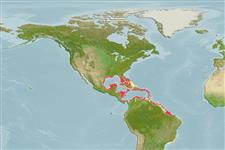Common names from other countries
>
Syngnathiformes (Pipefishes and seahorses) >
Syngnathidae (Pipefishes and seahorses) > Syngnathinae
Etymology: Hippocampus: Greek, ippos = horse + Greek,kampe = curvature (Ref. 45335).
More on author: Ginsburg.
Environment: milieu / climate zone / depth range / distribution range
Ecologia
marinhas; estuarina associadas(os) a recifes; não migratória; intervalo de profundidade 0 - 60 m (Ref. 30915). Subtropical; 29°N - 25°S, 133°W - 40°W (Ref. 57010)
Western Atlantic: USA (North Carolina) to Brazil; the Caribbean Sea.
Length at first maturity / Tamanho / Peso / Idade
Maturity: Lm 8.0 range ? - ? cm
Max length : 17.5 cm OT macho/indeterminado; (Ref. 30915)
Espinhos dorsais (total) : 0; Raios dorsais moles (total) : 16 - 19.
Uncommon in most areas, but may be locally common in certain places. Usually attached to gorgonians or seagrasses but may occur in floating Sargassum or swimming freely in midwater (Ref. 9710). Ovoviviparous (Ref. 205). The male carries the eggs in a brood pouch which is found under the tail (Ref. 205). Has been reared in captivity (Ref. 35409). Length type refers to Height (= from top of coronet to the tip of straightened tail). Maximum depth reported taken from Ref. 128812.
Breeding season more than 8 months in laboratory; egg diameter 1.2 mm; gestation period 2 weeks, depending on water temperature; young approximately 7 mm at birth; pair-bonded in wild (Ref. 30915). Monogamous mating is observed as both obligate and genetic (Ref. 52884).
Lourie, S.A., R.A. Pollom and S.J. Foster, 2016. A global revision of the seahorses Hippocampus Rafinesque 1810 (Actinopterygii: Syngnathiformes): taxonomy and biogeography with recommendations for further research. Zootaxa 4146(1):1-66. (Ref. 115213)
Categoria na Lista Vermelha da IUCN (Ref. 130435)
Ameaça para o homem
Harmless
Utilização humana
Pescarias: pouco comercial
Ferramentas
Relatórios especiais
Descarregue XML
Fontes da internet
Estimates based on models
Preferred temperature (Ref.
115969): 24 - 28, mean 26.7 (based on 164 cells).
Phylogenetic diversity index (Ref.
82804): PD
50 = 0.5000 [Uniqueness, from 0.5 = low to 2.0 = high].
Bayesian length-weight: a=0.00447 (0.00177 - 0.01127), b=3.00 (2.78 - 3.22), in cm Total Length, based on LWR estimates for this (Sub)family-body shape (Ref.
93245).
Nível Trófico (Ref.
69278): 3.4 ±0.5 se; based on size and trophs of closest relatives
Resiliência (Ref.
120179): Médio, tempo mínimo de duplicação da população 1,4 - 4,4 anos (Assuming annual Fec<1000).
Fishing Vulnerability (Ref.
59153): Low vulnerability (12 of 100).
